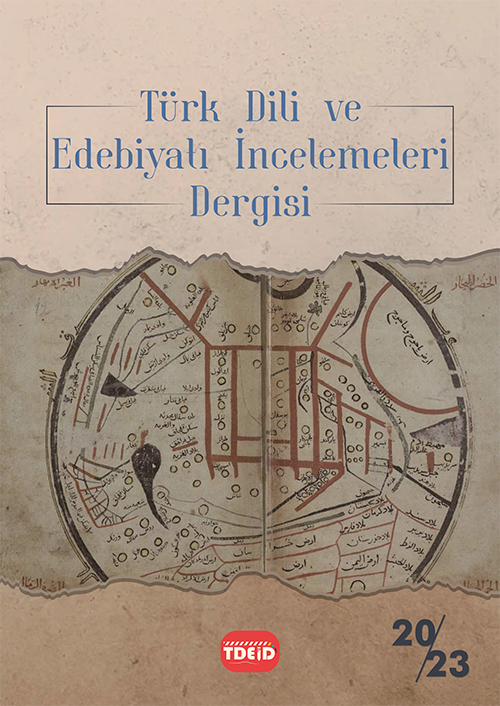Analyzing Menâkıb-ı Şeyh-i San’an Masnavi with Archetypal Critisim Method
DOI:
https://doi.org/10.5281/zenodo.12624479Keywords:
Menâkıb-ı Şeyh-i San'an, archetypal criticism, anima, persona, Classical Turkish LiteratureAbstract
In Classical Turkish literature, modern methods of criticism are used in addition to classical methods of analysis in understanding mesnevis. However, studies on this subject are new and few in number. As a matter of fact, the work Menâkıb-ı Şeyh-i San'an, which is the subject of this study, has not been analyzed with the archetypal criticism method, one of the modern criticism methods. Menâkıb-ı Şeyh-i San'an is a work of unknown authorship written in the genre of menâkıbnâme in masnavi verse form. The aim of this study is to analyze Menâkıb-ı Sheikh-i San'an with the archetypal method. In this study, in which the main protagonist of the work, Sheikh-i San'an, was taken as the center, it was seen that the archetypal criticism method and the analysis of Menâkıb-ı Sheikh-i San'an contributed to the understanding of the events in the work. The archetypal criticism method is based on Carl G. Jung's work in the field of analytical psychology and emerged with the application of this theory to works of art. In this context, archetypes, which are the manifestation of the collective unconscious in the narratives of the human subject, are revealed by examining the deep structure of the work. In this study, the archetypes of anima, animus, persona, shadow, sage and search are analyzed through Mustafa Güneş's Menākıb-ı Şeyh-i San'an based on the events that Şeyh-i San'an went through and the people he encountered. This study consists of introduction, archetypal criticism method and archetypes, archetypes in Menākıb-ı Şeyh-i San'an and conclusion. In the introduction section, information about the work is given considering that the work is written in the form of masnavi verse and in the genre of manhīb. After the introduction, the study is analyzed in two separate sections. In the first part, the method of archetypal criticism and the concept of archetype are emphasized and the concepts such as persona, shadow, anima, animus, sage, etc. are explained. The second part of the study consists of the analysis of archetypes in Menâkıb-ı Şeyh-i San'an. In this section, after summarizing the events that the main protagonist Sheikh-i San'an went through, the related couplets in the work are analyzed under the titles of the hero in love, persona and shadow, anima and animus, sage and quest, journey and maturation. In the conclusion section, it is emphasized that the works of the menâkıbname genre will be better understood when analyzed with the method of archetypal criticism.
References
Babür, Yusuf (2013). Şeyh-i San’an Kıssasına Dair, Turkısh Studies, s.509-516. Ankara.
Çağlar, Abiha Birsel (2021). Hüsrev ü Şirin Mesnevisi Üzerine Arketipsel Bir Yaklaşım Denemesi, Çukurova Üniv.Türkoloji Dergisi.
Güneş, Mustafa (2011). Menâkıb-ı Şeyh-i San’an (Metin, Günümüz Türkçesine Aktarım ve Tıpkıbasım), Eğitim Akademi Yayınları, Konya.
Gürol, Ender (2006). Carl Gustave Jung, Analitik Psikoloji, Payel Yay. İkinci Basım, İstanbul, s.50, 52.
Gürses, İbrahim (2007). Jung’cu Arketip Teorisi Bağlamında Tasavvufi Öykülerin Değerlendirilmesi, Uludağ Üniv. İlahiyat Fak. Dergisi. C.16, Sayı: 1, s.77-96.
Gürses, Sabri (2000). J.Campbell, Kahramanın Sonsuz Yolculuğu, Kabalcı Yayınevi.
Harmancı, Mehmet (1996). Ronald B. Tobias, Roman Yazma Sanatı, Say Yay, s.261-262.
Karagözlü, Volkan, (2012). Arketipsel Sembolizm Bağlamında Mihr ü Vefâ Mesnevisinin İncelenmesi, Turkısh Studies, s.1406-1421.
Kayaoktay, İlyas (2014). Fuzuli’nin Leyla ile Mecnun Mesnevisinin Arketipsel Sembolizm Bağlamında Çözümlenmesi, Akademik Sosyal Araştırmalar Dergisi, Yıl:2 Sayı: 7, s. 337-351.
Moran, Berna (1988). Edebiyat Kuramları ve Eleştiri, Cem Yay. Kültür Dizisi, İstanbul, s.189-190.
Oğuz, Nazmiye, Enes İlhan (2014). Geleneğin Yeniden Üretilmesi Bağlamında Attar, Gülşehri ve Ali Şir Nevai’nin Mesnevilerinde Şeyh-i San'an Kıssası, Uluslar arası Sosyal Araştırmalar Dergisi, C.7, Sayı:35.
Sevgi, H. Ahmet (2003). “Mantıku’t-Tayr”, Türkiye Diyanet Vakfı İslam Ansiklopedisi, C.28, s.29-30.
Şahin, Haşim (2004). “Menâkıbnâme”, Türkiye Diyanet Vakfı İslam Ansiklopedisi, C.29, s.112-114.
Ünver, İsmail ( 1986). Mesnevi, Türk Dili, Türk Şiiri Özel Sayısı II (Divan Şiiri), Sayı: 415-416-417, s. 430-563.
Yazar, Sadık (2010). Mütercimi Belirsiz Bir Şeyh-i San’ân Mesnevisi, Turkish Studies, c.5, S.4, s. 1571 – 1631.
Yılmazer, Zehra Aksu (2003). Carl Gustave Jung, Dört Arketip, Metis Yay. İstanbul.
Downloads
Published
How to Cite
Issue
Section
License
Copyright (c) 2024 Türk Dili ve Edebiyatı İncelemeleri Dergisi

This work is licensed under a Creative Commons Attribution 4.0 International License.







